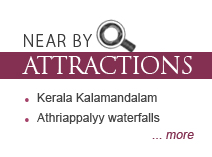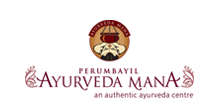
History
The name Thrissur is derived from 'Thiru-Shiva-Perur', which literally translates to "The City with the name of the Lord Siva". Thrissur was also known as "Vrishabhadripuram" and then "Kailasam" (Kailasam of the South) in ancient days. Another interpretation is 'Tri-shiva-peroor' or the big land with 3 Shiva temples, which refers to the three places where Lord Shiva resides - namely Vadakkumnathan Temple, Poonkunnam Shiva Temple and Peruvanam Siva temple. Linguistically PERU is not for NAME,Actually SIVA is called SIVAPERUMAN or sivaperumal.Thrissur is having more than a dozen SIVA temples,not three with in a radius of two Kms.
Pre-history
Starting from the Stone Age, Thrissur must have been the site of human settlement. This is evidenced by the presence of a megalithic monuments at Ramavarmapuram, Kuttoor, Cherur and Villadam. The Ramavarmapuram monument is in granite and is of Menhir type. The monument in Ramavarmapuram is 15 feet height and 12 feet 4 inches broad. From 1944, it is under the protection of Department of Archaeology. The monument is locally known as 'Padakkallu' or 'Pulachikkallu'. These menhirs are memorials for the departed souls put up at burial sites. They belong to the Megalithic Age of Kerala, which is roughly estimated between 1000 BCE and 500 CE. All such monuments have not been dated exactly. Some experts are of the view that these are the remnants of the Neolithic Age in the development of human technology. The Ramavarmapuram Menhir is also believed to be a monument belonging to the Sangam period in the South Indian history. Another monolithic monuments like Dolmens and rock-cut caves are at Porkulam, Chiramanengad, Eyyal, Kattakambal and Kakkad. According to historians, the Dolmens are burial sites. Though most of the monuments were well protected, the dolmen at Porkulam was in a neglected condition. The monument excavated under eminent Archaeologist BK Thapar, between 1949–50, was under the Department of Archaeology.[2] Another megalithic monument is situated at Ariyannur in Thrissur. This place has unravelled monuments such as the 'Kudakkallu' or 'Thoppikkallu' (Mushroom stones or Umbrella stones) and 'Munimada' (Saint's abode). The laterite hillocks of Ariyannur rise to about 50 metres. Another reference in Ariyannur dates back to early 15th century in the poem 'Chandrotsavam'.
Chera Dynasty
The early political history of the Thrissur and Thrissur district is interlinked with that of the Chera Dynasty of the Sangam age, who ruled over vast portions of Kerala with their capital at Vanchi. Kodungallur was also the capital of Cheraman Perumal, the last Chera ruler in the 7th century A.D. The legend is that he abdicated his throne and divided his kingdom among the local chieftains and left for Mecca to embrace Islam. This place was later ruled by the Kingdom of Cochin (Perumpadapu Swaroopam). During the time of the Chera ruler, Kodungallur was an important trade link in Indian Ancient Maritime History.
The whole of the present Thrissur district was included in the early Chera empire. The district can claim to have played a significant part in fostering the trade relations between Kerala and the outside world in the ancient and medieval period. It can also claim to have played an important part in fostering cultural relations and in laying the foundation of a cosmopolitan and composite culture in this part of the country. Muziris (Muchiri) was an important port city in the pre-historic era, was a part of it.
Muziris
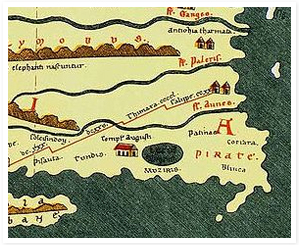 Muziris (1st century B.C.), is a lost port city in Kodungallur and was a major center of trade in kerala between the Chera Empire and the Roman Empire.[6]Muziris (Cranganore) was destroyed by massive flooding of the river Periyar in 1341 AD, opening a new port called Kochi.[7]Muziris was also known as Mahodayapuram, Shinkli, Muchiri (anglicised to Muziris) and Muyirikkodu. It is known as 'Vanchi' to locals.[6]Muziris opened the gates for Arabs, Romans, Portuguese, Dutch and English to Indian sub continent and South East Asia. Muziris dealers had set Indo-Greek and Indo-Roman trade with Egypt, which comes in gold and other metals, pepper and spices, precious stones and textiles.[8] It was famous as a major port for trade and commerce for more than 2,500 years. Muziris became of interest to classical authors because of the Romans' interest in trading, and their desire to have contact with regions beyond the reach of easy conquest and they set up trading routes with these places. Merchants from a number of cultures are believed to have operated in the port, and there are numerous Indian finds from the time as well as Roman ones.
Muziris (1st century B.C.), is a lost port city in Kodungallur and was a major center of trade in kerala between the Chera Empire and the Roman Empire.[6]Muziris (Cranganore) was destroyed by massive flooding of the river Periyar in 1341 AD, opening a new port called Kochi.[7]Muziris was also known as Mahodayapuram, Shinkli, Muchiri (anglicised to Muziris) and Muyirikkodu. It is known as 'Vanchi' to locals.[6]Muziris opened the gates for Arabs, Romans, Portuguese, Dutch and English to Indian sub continent and South East Asia. Muziris dealers had set Indo-Greek and Indo-Roman trade with Egypt, which comes in gold and other metals, pepper and spices, precious stones and textiles.[8] It was famous as a major port for trade and commerce for more than 2,500 years. Muziris became of interest to classical authors because of the Romans' interest in trading, and their desire to have contact with regions beyond the reach of easy conquest and they set up trading routes with these places. Merchants from a number of cultures are believed to have operated in the port, and there are numerous Indian finds from the time as well as Roman ones.
There has always been a lot of confusion about the exact location of the port, as also about other aspects of it. For long it was considered to be Kodungalloor. However, in 1983, a large hoard of Roman coins was found at a site around six miles from a place called Pattanam, some distance away from Kodungalloor. Excavations carried out from 2004 to 2009 at Pattanam has revealed evidence that may point out the exact position of Muziris.
The recent archaeological work done in the area has revealed fragments of imported Roman amphora, mainly used for transporting wine and olive oil, Yemeni and West Asian pottery, besides Indian roulette ware (which is also common on the East Coast of India, and also found in Berenice in Egypt).[6][9][10][11] This suggests that Muziris was a port of great international fame and that South India was involved in active trade with several civilizations of West Asia, the Near East and Europe with the port as a means to do so.
While there is a consensus on that both the port and the city ceased to exist around the middle of the 13th century CE, possibly following an earthquake (or the great flood of 1341 recorded in history, which caused the change of course of Periyar river), there does not seem to be clear evidence as to when the port might have first come into being. Presently, researchers seem to be agreed on that the port was already a bustling center of trade by 500 BCE, and there is some evidence that suggests that Muziris was a city, even if not certainly a port as well, from before 1500 BCE
It is called as 'Murachipatanam' in Sanskrit and Muchiri in Tamil. Later it was also called as Makothai, Mahodayapuram, Mahodayapattanam. The port was familiar to the author of the Periplus of the Erythraean Sea who described it as being situated on Pseudostomos river (ΨευδÏŒστομος: Greek for "false mouth" - a precise translation of the Malayalam description of the mouth of the Periyar, Alimukam) two miles from its mouth. According to the Periplus, numerous Greek seamen managed an intense trade with Muziris
Then come Naura and Tyndis, the first markets of Damirica (Limyrike), and then Muziris and Nelcynda, which are now of leading importance. Tyndis is of the Kingdom of Cerobothra; it is a village in plain sight by the sea. Muziris, of the same Kingdom, abounds in ships sent there with cargoes from Arabia, and by the Greeks; it is located on a river, distant from Tyndis by river and sea five hundred stadia, and up the river from the shore twenty stadia" - The Periplus of the Erythraean Sea
Muziris is also mentioned in the epics Ramayana, Mahabharatha, Akananuru, and Chilappathikaram. The poets Pathanjali and Karthiyayan have referred to it, as well as the travelogues of both Pliny the Elder and Ptolemy under different names. Moreover, Kodungallur (Muziris) is mentioned in the stone writings of Ashoka. It was known as Muziris to Pliny the Elder (N.H. 6.26), who describes it as primum emorium Indiae. The ancient Greek explorer Hippalus landed at this port after discovering the patterns of the Indian monsoon trade winds on his way from the aast African coast. Evidence of the Peutinger Table suggests that there was a temple dedicated to the Roman emperor Augustus. The Greeks, the Romans (known locally as the Yavanas) and the Jews, Arabs etc. all have come to this place at different times in its history.
Roman gold and silver coins bearing impressions of Roman Emperors Tiberius and Nero were discovered in the village Kochal in Valluvally near Paravur near the town in 1983. A 2nd-century papyrus from Egypt concerning the transshipment of goods originating in Muziris from the Red Sea to Alexandria attests to the continued importance of the port in the Indian Ocean commerce trade a century after Pliny and the Periplus
Thomas the Apostle (A.D. 51-52)
Statue of St. Thomas at Palayoor in Thrissur district. In A.D. 52 St Thomas landed at Palayoor by boat from Muziris. He came to visit the Jewish merchants at Palayur Judankunnu and to preach the good news in course of time. The indigenous church of Kerala has a tradition that St. Thomas sailed there to spread the Christian faith. He landed at the ancient port of Muziris. He then went to Palayoor (near present-day Guruvayoor), which was a Hindu priestly community at that time. He left Palayoor in AD 52 for the southern part of what is now Kerala State, where he established the Ezharappallikal, or "Seven and Half Churches". These churches are at Kodungallur, Kollam, Niranam, Nilackal (Chayal), Kokkamangalam, Kottakkayal (Paravoor), Palayoor (Chattukulangara) and Thiruvithancode Arappally - the half church.
"It was to a land of dark people he was sent, to clothe them by Baptism in white robes. His grateful dawn dispelled India's painful darkness. It was his mission to espouse India to the One-Begotten. The merchant is blessed for having so great a treasure. Edessa thus became the blessed city by possessing the greatest pearl India could yield. Thomas works miracles in India, and at Edessa Thomas is destined to baptize peoples perverse and steeped in darkness, and that in the land of India." - Hymns of St. Ephraem, edited by Lamy (Ephr. Hymni et Sermones, IV).
Cheraman Juma Masjid (A.D. 629)
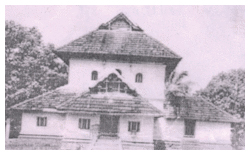 Believed to be built in 629 AD by Malik Bin Deenar, Cheraman Juma Masjid is considered as the oldest mosque in India, and the second oldest mosque in the world to offer Jumu'ah prayers.[20][21] Constructed during the lifetime of Muhammad, the bodies of some of his original followers are said to be buried here.[22] Unlike other mosques in Kerala that face westwards this mosque faces eastwards. Though, generally it is considered to be the second mosque of the world after the mosque in Medina, Saudi Arabia.
Believed to be built in 629 AD by Malik Bin Deenar, Cheraman Juma Masjid is considered as the oldest mosque in India, and the second oldest mosque in the world to offer Jumu'ah prayers.[20][21] Constructed during the lifetime of Muhammad, the bodies of some of his original followers are said to be buried here.[22] Unlike other mosques in Kerala that face westwards this mosque faces eastwards. Though, generally it is considered to be the second mosque of the world after the mosque in Medina, Saudi Arabia.
The legend has it that a group of Muhammad's Sahaba (companions) visited Kodungallur. Cheraman Perumal (Rama Varma Kulashekhara), then the Chera ruler, had witnessed a miraculous happening — the sudden splitting of the moon, the celebrated miracle of Muhammad — and learned on inquiry that this was a symbol of the coming of a Messenger of God from Arabia. Soon after, Perumal travelled to Makkah, where he embraced Islam, and accepted the name Thajudeen. On his way back to India he died at Salalah in the Sultanate of Oman. On his deathbed he is said to have authorised some of his Arab companions to go back to his kingdom to spread Islam. Accordingly, a group of Arabs led by Malik Bin Deenar and Malik bin Habib arrived in north Kerala, and constructed the Cheraman Juma Masjid at Kodungalloor.
Cochin Royal Family
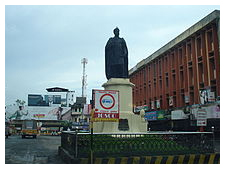 There is no extant written evidence about the emergence of Kingdom of Cochin or of the Cochin Royal Family, also known as Perumpadapu Swaroopam.[25] All that is recorded are folk tales and stories, and there is a somewhat blurred historical picture about the origins of the ruling dynasty. The surviving manuscripts, such as Keralolpathi, Keralamahatmyam, and Perumpadapu Grandavari, are collections of myths and legends that are less than reliable as conventional historical sources.
There is no extant written evidence about the emergence of Kingdom of Cochin or of the Cochin Royal Family, also known as Perumpadapu Swaroopam.[25] All that is recorded are folk tales and stories, and there is a somewhat blurred historical picture about the origins of the ruling dynasty. The surviving manuscripts, such as Keralolpathi, Keralamahatmyam, and Perumpadapu Grandavari, are collections of myths and legends that are less than reliable as conventional historical sources.
There is an oft-recited legend that the last Perumal who ruled Kerala divided his kingdom between his nephews and his sons, converting to Islam and traveling to Mecca on a hajj. The Keralolpathi recounts the above narrative in the following fashion:
The last and the famous Perumal king Cheraman Perumal ruled Kerala for 36 years. He left for Mecca by ship with some Muslims who arrived at Kodungallur (Cranganore) port and converted to Islam. Before leaving for Mecca, he divided his kingdom between his nephews and sons.
The Perumpadapu Grandavari contains an additional account of the dynastic origins: The last Thavazhi of Perumpadapu Swaroopam came into existence on the Kaliyuga day shodashangamsurajyam. Cheraman Perumal divided the land in half, 17 amsha north of Neelaeswaram and 17 amsha south, totaling 34 amsha, and gave his powers to nephews and sons. Thirty-four rajyas between Kanyakumari and Gokarna, now in Karnataka were given to the Thampuran who was the daughter of the last niece of Cheraman Perumal.
Keralolpathi recorded the division of his kingdom in AD 345, Perumpadapu Grandavari in 385, Loghan (a historian) in 825. There are no written records on these earlier divisions of Kerala, but according to writer Elamkulam Kunjan Pillai, a division might have occurred during the Second Chera Kingdom, at the beginning of 12th century.
The history of Thrissur from the 9th to the 12th centuries is the history of Kulasekharas of Mahodayapuram and the history since 12th century is the history of the rise and growth of Perumpadapu Swaroopam. In the course of its long and chequered history, the Perumpadappu Swarupam had its capital at different places. According to the literary works of the period, the Perumpadapu Swaroopam had its headquarters at Mahodayapuyram and had a number of Naduvazhies in southern Kerala. Central Kerala recognised the supremacy of the Perumpadappu Moopil and he is even referred to as the 'Kerala Chakravarthi' in the 'Sivavilasam' and some other works
One of the landmarks in the history of the Perumpadapu Swaroopam is the foundation of a new era called Pudu Vaipu era. The Pudu Vaipu era is traditionally believed to have commenced from the date on which the island of Vypeen was thrown from the sea. The 14th and 15th centuries constituted a period of aggressive wars in the course of which the Zamorins of Calicut acquired a large part of the present Thrissur district. In the subsequent centuries the Portuguese dominated the scene. By the beginning of the 17th century the Portuguese power in Kerala was on the verge of collapse. About this time other European powers like the Dutch and the English appeared on the scene and challenged the Portuguese. Internal dissension in the Perumpadappu Swarupam helped the Dutch in getting a footing on the Kerala coast. As the Kerala chiefs were conscious of the impending doom of the Portuguese, they looked upon the Dutch as the rising power and extended a hearty welcome to them.
Parukutty Nethyar Amma & Kuruppath Family: History
 Maharaja Rama Varma (popularly known as Madrassil Theepetta Thampuran), who reigned from 1914 to 1932, was assisted by a particularly able consort named Parukutty Nethyar Amma (b.1874). The Nethyar was the daughter of Kurur Namboodiripad, who was a member of the family that had the traditional honour of anointing the kings of Palakkad. Her mother belonged to the Padinjare Shrambhi house of the aristocratic Vadakke Kuruppath house of Thrissur. She married the Maharaja, then fourth in line to the succession, when she was fourteen years old in 1888. It is said that she was especially blessed by the Devi at the Chottanikkara Temple. By a quirk of fate her husband ascended the throne as a result of the abdication of his predecessor. Since the Maharaja was a scholar and had other interests (including knowledge of how to cure snake bites and comprehend the language of lizards known as Gawli Shashtra), she took over the finances of the state. Under her guidance salaries were quadrupled and the increased revenue earned her a 17-gun salute. Parukutty Nethyar Amma was awarded the Kaiser-i-Hind medal by King George V in 1919 for public work and came to be known as Lady Rama Varma of Cochin.
Maharaja Rama Varma (popularly known as Madrassil Theepetta Thampuran), who reigned from 1914 to 1932, was assisted by a particularly able consort named Parukutty Nethyar Amma (b.1874). The Nethyar was the daughter of Kurur Namboodiripad, who was a member of the family that had the traditional honour of anointing the kings of Palakkad. Her mother belonged to the Padinjare Shrambhi house of the aristocratic Vadakke Kuruppath house of Thrissur. She married the Maharaja, then fourth in line to the succession, when she was fourteen years old in 1888. It is said that she was especially blessed by the Devi at the Chottanikkara Temple. By a quirk of fate her husband ascended the throne as a result of the abdication of his predecessor. Since the Maharaja was a scholar and had other interests (including knowledge of how to cure snake bites and comprehend the language of lizards known as Gawli Shashtra), she took over the finances of the state. Under her guidance salaries were quadrupled and the increased revenue earned her a 17-gun salute. Parukutty Nethyar Amma was awarded the Kaiser-i-Hind medal by King George V in 1919 for public work and came to be known as Lady Rama Varma of Cochin.
 The Nethyar Amma was not only an able administrator but also a Nationalist, moving from being seen as an exemplary public figure in the eyes of the British to earning the ire of the colonial state for her relationships with Mahatma Gandhi and Indian nationalists. As one British intelligence report stated, "The hill palace is the centre of nationalist activity and charkhas have been introduced to assist the weaving of khadi." (see Fortnightly Intelligence Reports available at the National Archives of India) In addition, a little known fact about the Cochin state is the attempt made by the British government and the Viceroy to force the Maharajah to abdicate under the ploy of trying to prove him insane. A doctor was brought from London to bolster the case, and the physician opined that the "Maharaja was merely an old man who tired easily". This attempt was directly linked to the fear that the Nethyar Amma, or the "Consort" as she was referred to by the British, was becoming increasingly powerful in nationalist circles.
The Nethyar Amma was not only an able administrator but also a Nationalist, moving from being seen as an exemplary public figure in the eyes of the British to earning the ire of the colonial state for her relationships with Mahatma Gandhi and Indian nationalists. As one British intelligence report stated, "The hill palace is the centre of nationalist activity and charkhas have been introduced to assist the weaving of khadi." (see Fortnightly Intelligence Reports available at the National Archives of India) In addition, a little known fact about the Cochin state is the attempt made by the British government and the Viceroy to force the Maharajah to abdicate under the ploy of trying to prove him insane. A doctor was brought from London to bolster the case, and the physician opined that the "Maharaja was merely an old man who tired easily". This attempt was directly linked to the fear that the Nethyar Amma, or the "Consort" as she was referred to by the British, was becoming increasingly powerful in nationalist circles.
The head of the Congress party in Cochin was Kurur Nilakantan Namboodiripad who was a cousin of the Nethyar Amma. The Collected Works containing Gandhi's letters include correspondence between the Maharajah's daughter V. K. Vilasini Amma and himself, and a second daughter V.K Ratnamma was married to R. M. Palat, himself a politician and the son of Sir C. Sankaran Nair, the former president of the Congress Party and well known nationalist.[13] The Maharaja's son V.K Aravindaksha Menon was married to Malathy, the daughter of V. K Narayana Menon a prominent contractor in Thrissur in whose house "Pandyala", Jawaharlal Nehru, Kamala and Indira Nehru rested on their way to Sri Lanka. When Gandhi visited Cochin, he was treated as a state guest, and Aravindaksha Menon, the Nethyar Amma's son personally was deputed to accompany him. Soon Parukutty Nethyar Amma appeared opposed, which proved to be a significant hurdle for British interests in India.

